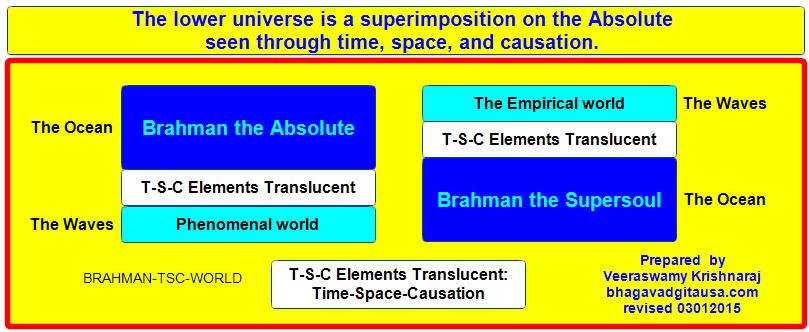NYAYAS: Illustrations or Analogies
Veeraswamy Krishnaraj
Rajjusarpa Nyaya: Rope-Snake Analogy.
Raju was a nervous child always afraid of darkness. As a two-year old
child, he did not understand why there is a shadow following him
wherever he went. He asked no one the reason behind the shadow.
Sometimes the shadow was behind him, sometimes in front of him, and
sometimes to his right or left. It mystified him. He ran and it ran with
him. The only time he did not see his shadow was in the dark of night.
In the twilight, the shadow was faint, gradually disappearing in the
creeping night. He discovered the morning and evening sun cast a long
shadow of him. When he was five, he asked his father the cause for the
shadow following him.
The father explained where the sun is shining on an object, the object
blocked the sun and produced a shadow. The father illustrated this truth
by placing a pot under the early morning sun. The pot appeared long and
black in the shadow. The boy realized when the pot was removed the
shadow was gone.
He was walking home from his uncle’s a few blocks away in the dusk. He
saw what he thought was a snake on the road. He ran out of fear, reached
home and told his father. He took his father where he saw the snake. The
father looked at it and said that the snake
was a rope that appeared like a snake. He let his son shine a
flashlight on it. The boy saw it was a rope and the snake was an
illusion.
A rope is mistaken for a snake: Illusion and Superimposition. A rope in
the dim light appeared as a snake to the boy, causing fear in him. The
snake is not real but a superimposition on the real rope. The boy
experienced the snake was imagined and a threat was perceived. The
threat and fear were misplaced but disappeared on knowing the false
snake was really a rope.
The world is a superimposition on Brahman. When Brahman is known by realization, the world disappears and the Brahman comes into view. The Brahman and the world are one because The Brahman projects the world through Māyā-Sakti. In one instance, Brahman and Māyā are two sides of the coin. In the next instance, Māyā and Sakti are two sides of the coin.
The snake depends on the rope to project its falsity. Likewise, the
world depends on Brahman to project its falsity. We live in falsity
until we realize Brahman. If there is no rope, there is no snake.
If there is no Brahman, there is no world. The snake is
rope-dependent. The phenomenal world is Brahman-dependent. The snake and
the world are real and unreal simultaneously. Likewise, there is no
individual soul, if there is no Brahman or Universal Soul.
There is no individuality other than Brahman. He is (Aham).
Individuality is apparent because of the mind and Māyā.
Brahman-TSC-World.jpg
Allegory. Brahman is the Supersoul (or the ocean). The ocean waves exist
because of the ocean. In this allegory the world, the world phenomena
and the beings are dependent on the Brahman. When there is no Brahman
(ocean), there is no world…(waves). The obscuring principle between the
Brahman and the world, beings… is
Māyā.
Verse 1.
विश्वं दर्पणदृश्यमाननगरीतुल्यं निजान्तर्गतं
पश्यन्नात्मनि मायया बहिरिवोदभूतं यथा निद्रया।
यः साक्षात्कुरुते प्रबोधसमये सवात्मानमेवाद्वयं
तस्मै श्रीगुरुमूर्तये नम इदं श्रीदक्षिणामूर्तये।।
visvaṁ
darpaṇa-dṛśyamāna-nagarī-tulyaṁ
nijāntar-gataṁ
paśyann-ātmani māyayā bahirivodbhūtaṁ yathā nidrayā/
yaḥ
sākṣāt-kurute prabhodha-samaye svātmānam-eva-advayaṁ
tasmai śrī guru-mūrtaye nama idaṁ śrī Dakṣiṇāmūrtaye//
The universe is like the city reflected in a mirror as an illusion,
exits within oneself, but arises in a manner of a world in a dream,
which disappears upon waking and realization that the universe is
non-dual with his own Self. To Him the divine teacher Sri
Dakshinamurthy, I offer my salutation.
Sankaracharya is the propounder of the theory of Māyā. Advaita proponent
Prakasatman explains, Brahman and Māyā constitute the whole universe,
just like the stationary longitudinal warp (thread) and the transverse
woof (thread) make the fabric. while Brahman is the substratum or the
hypostasis (warp), while Māyā is the manifest world (woof). In Advaita
Vedanta, there are two realities: Paramarthika and Vyavaharika (Absolute
Reality and empirical reality = Brahman and Māyā). We roil in the world
of happenings and Māyā keeps us bound to the empirical world. It is like
a cloud (Māyā) hiding the sun (Brahman). The veil conceals Brahman.
Faustian Māyā has the disposition and power to conceal Spiritual Reality
(Brahman). The products of Māyā take birth, live, morph, mutate, evolve
and die with time.
Brahman’s magic is Māyā. The magician only knows all parts of the
equation. Man is mesmerized with the magic and thinks delusively Māyā is
real (now for the moment and the present) though an illusion. The True
Real is Brahman who is the purveyor of Māyā. Māyā exists in a state of
flux and change
and Faustian (=
sacrificing spiritual values for power, knowledge, or material gain).
One should strive for and attain spiritual knowledge and know the
principles behind the magic to attain liberation and union with Brahman.
It is the rope and the snake. Rope is Brahman without a second; the
snake is the illusion. With knowledge and illumination, the snake
disappears and the Brahman remains as the eternal hypostasis.
While Brahman is Spiritual, Māyā is empirical and veiling.
The goal of man is to rip the veil of
Māyā, obtain liberation and realize Brahman.
